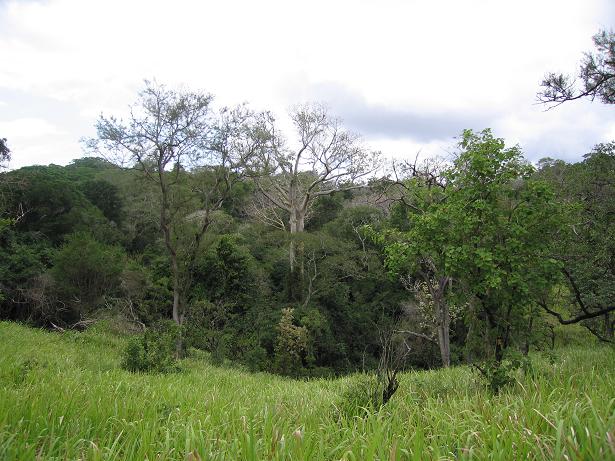Adansonia-Consulting |
|||||||||||
Applied Research
The applied research programme in East Africa includes the following main topics:
Preliminary studies, kindly supported by KFPE (Swiss Commission for Research Partnerships with Developing Countries) and ESAPP (Eastern and Southern Africa Partnership Programme pdf), showed that soils under forest exhibit a very strong increase in 13C with soil depth (up to 6‰), which is two to three times higher than the natural 13C enrichment in typical forest soils. We have interpreted this as a clear indication that these sites which are currently under forest had a much higher abundance of C4-grasses in the past. On the other hand, soil organic matter at savanna sites has remarkably stable isotopic signatures, which indicates the persistence of savannas over several centuries (millennia). The Miombo woodland boundary is currently expanding at the expense of the savanna at several locations in northwestern and eastern-central Tanzania according to the former C4 (savanna) signature of the subsoil. None of the samples has been dated by radio carbon so far. In a new Project phase, land-use changes and vegetation shifts at different geomorphic locations along transects through Miombo woodlands and savanna landscapes in Kagera, Shinyanga, Morogoro and Tanga Region have been assessed in more detail. Large scale vegetation changes in the Miombo woodlands (including the adjacent savannas) have been studied along decreasing rainfall gradients considering the geomorphic location. On a smaller scale, vegetation sites of the savanna landscape have been analysed along transects through small dry evergreen forest formations extending into open savanna on either side. The results from the Kagera savann landscape suggest that forest patches are very stable vegetation formations which have persisted for millennia. During the last millennium, they have been expanding very slowly into the surrounding savanna at a rate of less than 15 m per century. The research partnership has contributed to strengthen the research capacity of both parties. The complementary knowledge of both partners was very beneficial for the implementation of the Project. For more information please contact Dr. P.K.T. Munishi from SUA (pmunishi2001@yahoo.com) or Dr. U. Bloesch, consultant from WSL (bloesch@swissonline.ch). Threatened plant species of not yet surveyed coastal forest patches in Handeni District, Tanzania
New tree and shrub species discovered in Tanzania
Ethno-ecological study on the woody plants of Rwanda
Publication: Klötzli, F. & Bloesch, U. et al. (1999) Manifest: Welche Forschung braucht der Naturschutz heute? Vierteljahrsschrift der Naturforschenden Gesellschaft in Zürich, 144(3): 89-100. Bloesch, U., Bosshard, A., Schachenmann, P., Rabetaliana Schachenmann, H. & Klötzli, F. (2002) Biodiversity of the subalpine forest/grassland ecotone of the Andringitra Massif, Madagascar. In: Körner, Ch. & Spehn, E. M. (eds.) Mountain biodiversity: a global assessment, pp. 165-175. Parthenon Publishing, London. Bloesch, U. (2002) The dynamics of thicket clumps in the Kagera savanna landscape, East Africa. PhD thesis No 14386, Swiss Federal Institute of Technology Zurich (ETH). Shaker, Aachen. Bloesch, U.& Klötzli, F. (2005) Zur Waldfähigkeit der Saadani - Küstensavannen in Tansania. Berichte der Reinhold-Tüxen-Gesellschaft, 17: 55-69. Bloesch, U. (2008) Thicket clumps: A characteristic feature of the Kagera savanna landscape, East Africa. Journal of Vegetation Science, 19: 31-24. pdf Bloesch, U., Troupin, G. & Derungs, N. (2009) Les plantes ligneuses du Rwanda. Flore, écologie et usages. Shaker, Aachen. link Nduwamungu, J., Munishi, P.K.T., Bloesch, U., Hagedorn, F. & Lulu, K. (2009) Recent land cover and use changes in miombo woodlands of eastern Tanzania. Tanzania Journal of Forestry and Nature Conservation, 78: 50-59. pdf Wiedemeier, D.B., Bloesch, U., Hagedorn, F. (2012) Stable forest-savanna mosaic in northwestern Tanzania: local-scale evidence from d13C signatures and 14C ages of soil fractions. Journal of Biogeography, 39: 247-257. pdf Belem, B., Kaguembega-Mueller, F., Bellefontaine, R., Sorg, J.P., Bloesch, U. & Graf, E. (2017) Assisted natural regeneration with fencing in the central and northern zones of Burkina Faso. Tropicultura, 35(2), 73-86. pdf Leiterer, R., Bloesch, U., Wulf, H., Eugster, S. & Joerg, P.C. (2018) Vegetation monitoring in refugee-hosting areas in South Sudan. Applied Geography 93, 1-15. pdf
|
|||||||||||



